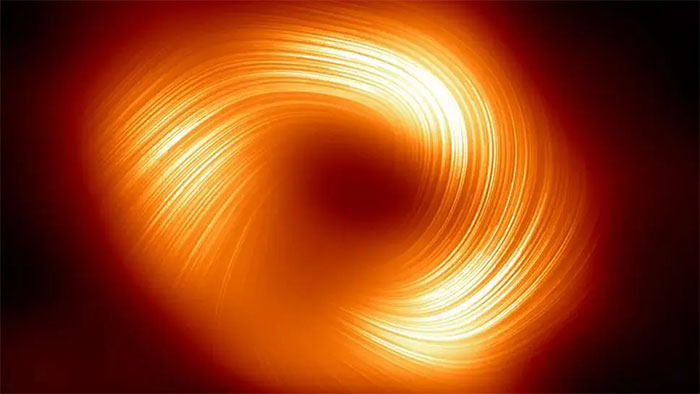The Milky Way's monster black hole is alive, spewing 'death rays'
New photos show that the monster black hole Sagittarius A* may not actually be "sleeping".
Sagittarius A* is a monster black hole located at the center of the Milky Way, the galaxy where Earth resides.
Unlike all previous images, the new images were taken by the Event Horizon Telescope (EHT) - a "virtual telescope" created by a network of many radio observatory dishes scattered around the world. world - photographed using polarized light.

Latest image of the monster black hole Sagittarius A* - (Photo: EHT).
Polarized light is a type of light made up of waves vibrating in one plane. The human eye cannot distinguish it from other types of light, but telescopes can.
Matter orbiting the black hole's event horizon - the area where everything, including light, is affected by the black hole's gravity - emits a lot of polarized light, making it stand out in the image. new photo.
It is aligned along magnetic field lines, creating an image that looks like a tornado of light covering the area where the monster Sagittarius A* is located.
And this image shows something special: Even though it is in a quiet state after a period of intense activity, this black hole is still alive, awake in a certain sense.
It is continuously emitting hidden rays, shooting streams of super-hot material across the galaxy.
However, you don't need to worry too much, because these "death rays" do not have the strength to reach Earth, which is located in a star system at the edge of the galaxies.
The new image also reveals that the magnetic field of the monster Sagittarius A* is more powerful and complex than previously thought. Its magnetic field is very similar to that of M87*, another monster black hole that is 1,000 times more massive than Sagittarius A* and located 53 million light years away.
- Monster black holes are 100,000 times bigger than the Sun.
- Super black holes bombard the Earth with powerful cosmic rays
- Monster black hole 'belching' twice after swallowing gas
- Stunned 'cosmic monster' by 50,000 times the Sun
- Discover the mystery of the most exotic black holes in the universe
- The center of the Milky Way may contain thousands of black holes
- Discovering the Milky Way's new black hole
- Witness the 'meal' of the super black hole
- The Milky Way's black hole may have erupted a giant air bubble
- The endless dance between the Milky Way
- Close up of the black hole of the Milky Way
- Detecting a black hole
 Van Allen's belt and evidence that the Apollo 11 mission to the Moon was myth
Van Allen's belt and evidence that the Apollo 11 mission to the Moon was myth The levels of civilization in the universe (Kardashev scale)
The levels of civilization in the universe (Kardashev scale) Today Mars, the sun and the Earth are aligned
Today Mars, the sun and the Earth are aligned The Amazon owner announced a secret plan to build a space base for thousands of people
The Amazon owner announced a secret plan to build a space base for thousands of people